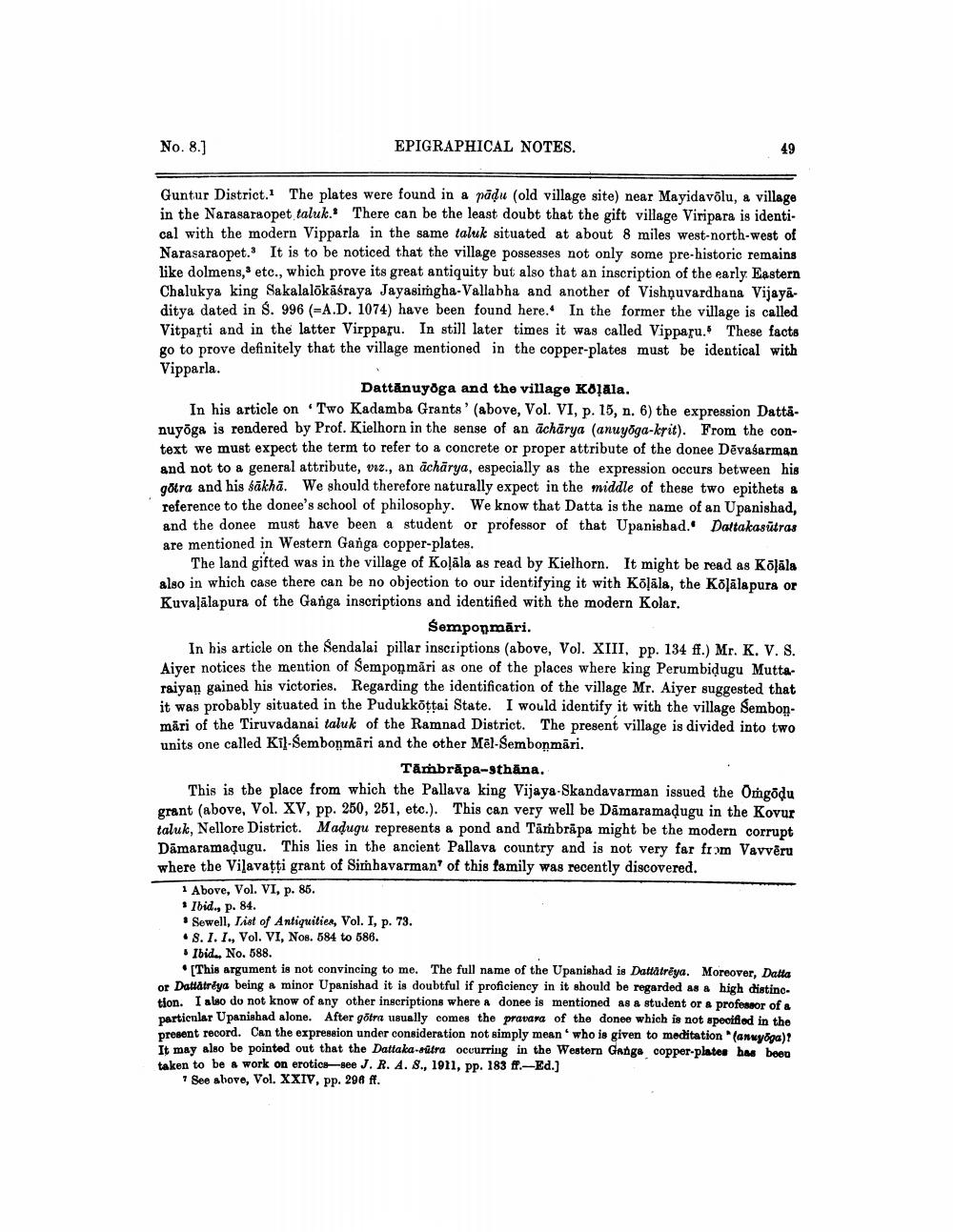________________
No. 8.)
EPIGRAPHICAL NOTES.
9
Guntur District. The plates were found in a pădu (old village site) near Mayidavõlu, a village in the Narasaraopet taluk. There can be the least doubt that the gift village Viripara is identical with the modern Vipparla in the same taluk situated at about 8 miles west-north-west of Narasaraopet. It is to be noticed that the village possesses not only some pre-historic remains like dolmens, etc., which prove its great antiquity but also that an inscription of the early Eastern Chalukya king Sakalalõkāsraya Jayasimgha-Vallabha and another of Vishņuvardhana Vijayaditya dated in $. 996 (A.D. 1074) have been found here. In the former the village is called Vitparti and in the latter Virpparu. In still later times it was called Vipparu. These facts go to prove definitely that the village mentioned in the copper-plates must be identical with Vipparla.
Dattanuyoga and the village Kojala. In his article on Two Kadamba Grants' (above, Vol. VI, p. 15, n. 6) the expression Dattanuyoga is rendered by Prof. Kielhorn in the sense of an ācharya (anuyoga-krit). From the context we must expect the term to refer to a concrete or proper attribute of the donee Dēvasarman and not to a general attribute, viz., an achārya, especially as the expression occurs between his gotra and his sākha. We should therefore naturally expect in the middle of these two epithets & reference to the donee's school of philosophy. We know that Datta is the name of an Upanishad, and the donee must have been a student or professor of that Upanishad. Dattakasūtras are mentioned in Western Ganga copper-plates.
The land gifted was in the village of Koļāla as read by Kielhorn. It might be read as Kölāla also in which case there can be no objection to our identifying it with Köļāla, the Köjālapura or Kuvaļālapura of the Ganga inscriptions and identified with the modern Kolar.
Semponmāri. In his article on the Sendalai pillar inscriptions (above, Vol. XIII, pp. 134 ff.) Mr. K. V. S. Aiver notices the mention of Sempoņmāri as one of the places where king Perumbidugu Mutta raiyan gained his victories. Regarding the identification of the village Mr. Aiyer suggested that it was probably situated in the Pudukkottai State. I would identify it with the village Sembonmari of the Tiruvadanai taluk of the Ramnad District. The present village is divided into two units one called Kil-Semboņmāri and the other Mēl-Sembonmäri.
Tambrāpa-sthāna. This is the place from which the Pallava king Vijaya-Skandavarman issued the Omgödu grant (above, Vol. XV, pp. 250, 251, etc.). This can very well be Dāmaramadugu in the Kovur taluk, Nellore District. Madugu represents a pond and Tambrāpa might be the modern corrupt Damaramadugu. This lies in the ancient Pallava country and is not very far from Vavvēru where the Vilavatti grant of Simbavarman of this family was recently discovered.
1 Above, Vol. VI, p. 85. • Ibid., p. 84. • Sewell, List of Antiquities, Vol. I, p. 73. .8.1. ., Vol. VI, Nos. 584 to 586. Ibid., No. 588.
This argument is not convincing to me. The full name of the Upanishad is Dattatreya. Moreover, Datta or Dattatreya being a minor Upanishad it is doubtful if proficiency in it should be regarded as a high distino. tion. I also do not know of any other inscriptions where a donee is mentioned as a student or a professor of a particular Upanishad alone. After gotras usually comes the pravara of the donee which is not specified in the present record. Can the expression under consideration not simply mean who is given to meditation anwyoga)? It may also be pointed out that the Dattaka-sutra occurring in the Western Ganga copper-plater has been taken to be a work on eroticasee J. R. A. 8., 1911, pp. 183 ff.-Ed.)
* See above, Vol. XXIV, pp. 298 ff.




